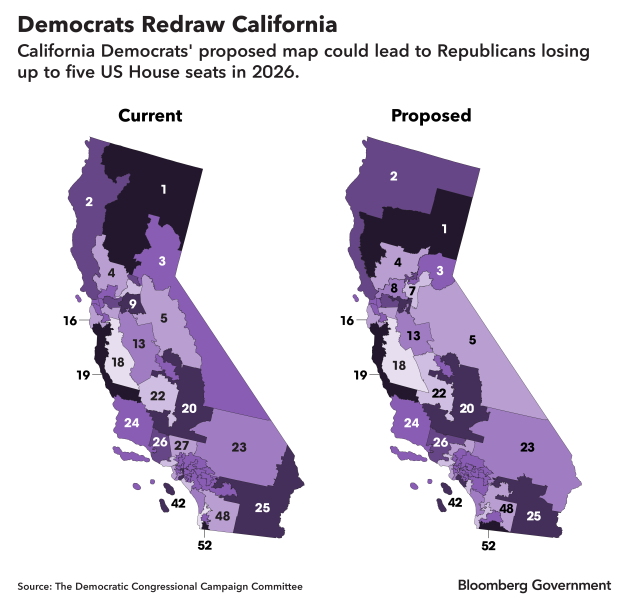Top Democrats released a draft congressional map Friday that may lead to Republicans losing five US House seats as Gov. Gavin Newsom pushes to offset possible GOP gains from redistricting in Texas.
The California map released by the Democratic Congressional Campaign Committee would imperil the 2026 re-election bids of Republicans including Reps.
“We will not stand by as Republicans attempt to rig the election in their favor and choose their voters,” Julie Merz, executive director of the Democratic Congressional Campaign Committee, said in a statement.
Kiley, a leading Newsom critic who represents some Sacramento suburbs and Lake Tahoe, would receive Democratic voters in Sacramento now represented by Rep. Doris Matsui (D) and Rep. Ami Bera (D). Kiley said he expects voters will reject the Democratic proposal, keeping his district intact. He’s sponsoring federal legislation to prohibit mid-decade redistricting nationwide.
“We will defeat Newsom’s sham initiative and vindicate the will of California voters,” he said in a post on X.
Campaign Shakeups
The proposed map would shake up several races ahead of a June 2, 2026, primary election, likely spurring additional candidates to jump into newly competitive seats while emboldening Democrats who have already launched campaigns targeting vulnerable Republicans such as Valadao, who represents a Central Valley swing district that would become a few points more Democratic.
The most conspicuous Republican targeted may be Calvert, a House member since 1993 and the most senior Republican in California’s congressional delegation. Calvert, who heads the House Appropriations Defense Subcommittee, won close re-elections in 2022 and 2024 in a Riverside County district that the draft map dismantles.
The map pairs Calvert with Kim in a Republican-leaning district in western Riverside County and eastern Orange County. Calvert presently represents about half of the people in that district, compared to about one-third for Kim. It also includes some of Issa’s Riverside County constituents.
Part of Calvert’s district, including the progressive bastion of Palm Springs, would be shifted to Issa’s district. Issa, who’s in his 12th House term, was the Oversight Committee Chair during Barack Obama’s presidency.
In the San Diego area, Democratic Reps.
In the northern end of the state, LaMalfa would see his district stretched from Republican-leaning corners of California’s interior to include more liberal-leaning areas around Santa Rosa, closer to the coast and the Democratic bastion of San Francisco.
The map would also boost Reps.
First-term Reps. Derek Tran (D) and Dave Min (D) would see their Orange County-centered districts shift more in their favor.
Tight Timeline
Democrats hold 43 of California’s 52 congressional districts, which were drawn by an independent commission under a process approved by voters in 2010 that was meant to take power over redistricting away from politicians.
Newsom is proposing to get around that process by asking voters to approve the new map directly.
California lawmakers, who return from summer recess Aug. 18, will have until Aug. 22 to pass legislation with support from supermajorities in the Senate and Assembly to formally call for the election, according to the secretary of state’s office.
Assembly and Senate committees plan to hold Aug. 19 hearings on the redistricting plan.
Democratic leaders in the legislature said Friday they will rush three separate measures to a vote by Aug. 21: a constitutional amendment authorizing new maps; a bill detailing the proposed maps; and a measure to call the election, change existing deadlines to make it possible to hold the vote, and provide funding.
The map would only take effect if approved by California voters, and if Texas or other states go ahead with redistricting plans, Newsom said. The redistricting commission would redraw the districts after the next census in 2030.
Eliyahu Kamisher in San Francisco also contributed to this story.
To contact the reporters on this story:
To contact the editors responsible for this story:



